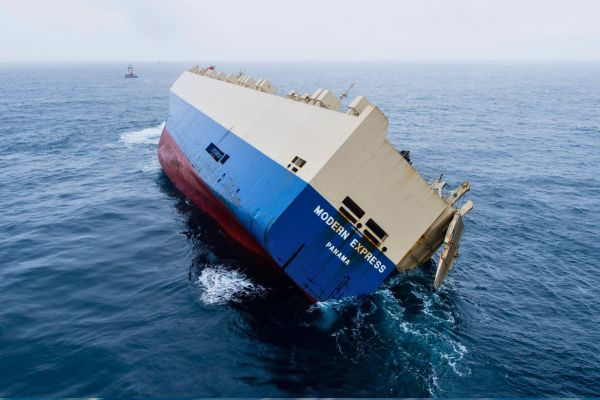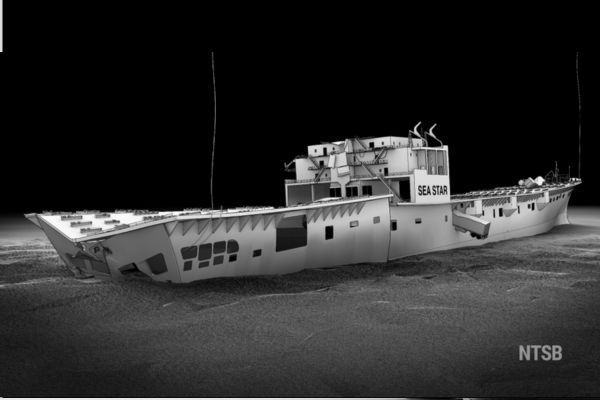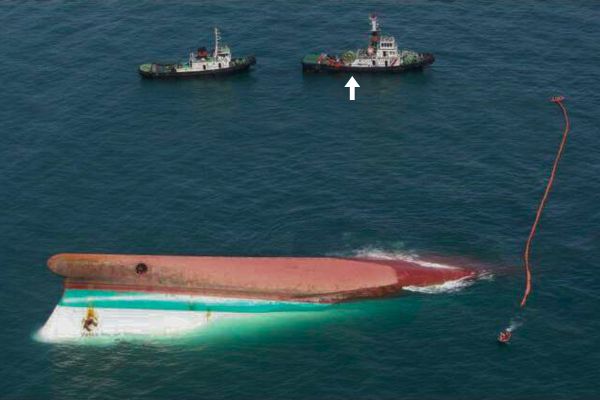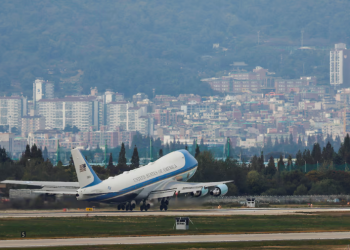The loss of these ships underscores the risks and challenges faced by the maritime industry. Each incident had its unique circumstances, such as fire outbreaks, severe weather conditions, navigational errors, or inadequate safety measures.
Felicity Ace:
Owner: Mitsui O.S.K. Lines
Date of Incident: February 16, 2022
Felicity Ace, a roll-on/roll-off cargo ship built in 2005, was a massive vessel owned by Mitsui O.S.K. Lines and registered in Panama. It was designed for transporting cars and trucks. Felicity met a tragic fate in February 2022. While carrying a cargo of 3,965 luxury cars from the Volkswagen Group, including renowned brands like Audi, Porsche, Lamborghini, and Bentley, a devastating fire broke out on board.
The Portuguese Navy successfully rescued all 22 crew members, but the ship, accompanied by the Portuguese Navy patrol ship NRP Setúbal, burned for nearly a week before ultimately capsizing and sinking in early March 2022. Industry analysts estimated the staggering cargo loss at an estimated value ranging between $334 million and $401 million.


MV Stellar Daisy:
Owner: Polaris Shipping
Date of Incident: March 31, 2017
MV Stellar Daisy, a South Korean Ore carrier, was built in 1993. It sank in the South Atlantic Ocean, on Friday, March 31, 2017. The ship was transporting iron ore from Brazil to China when it encountered severe weather conditions. Only two of the 24 crew members were rescued, and the remaining crew members were lost at sea. The exact cause of the sinking remains uncertain, but structural failure due to excessive cargo liquefaction is suspected.
El Faro:
Owner: TOTE Maritime
Date of Incident: October 1, 2015
El Faro, a US-flagged cargo ship, sank during Hurricane Joaquin in the Bahamas’ waters. All 33 crew members onboard perished in the accident. The subsequent investigation revealed a combination of factors contributing to the disaster, including the ship’s ageing design, inadequate maintenance, and the captain’s decision to sail close to the hurricane. The incident highlighted the need for improved safety protocols for vessels operating in adverse weather conditions.

MV Sewol:
Owner: Chonghaejin Marine Company
Date of Incident: April 16, 2014
MV Sewol was a South Korean passenger ferry that capsized and sank off the southwestern coast of South Korea. The ship was carrying 476 passengers, mostly high school students on a field trip. Due to insufficient safety measures, overloading, and crew negligence, 304 people lost their lives. The incident led to nationwide mourning and significant reforms in South Korea’s maritime safety regulations.

MV Costa Concordia:
Owner: Costa Crociere
Date of Incident: January 13, 2012
MV Costa Concordia, a cruise ship operated by Costa Cruises, struck a rock off the coast of Isola del Giglio, Italy. The impact caused the ship to capsize, resulting in the death of 32 people; although over 4,200 people were rescued. The incident was attributed to the captain deviating from the approved route and the subsequent mismanagement of the evacuation process. The salvage operation to remove the wreck was one of the most complex and expensive in history.

MV Princess of the Stars:
Owner: Sulpicio Lines
Date of Incident: June 21, 2008
MV Princess of the Stars was a Philippine passenger ferry that capsized and sank off the coast of San Fernando, Romblon, during Typhoon Fengshen. The ship was carrying over 800 passengers and crew members. Unfortunately, only 57 people survived, and the rest were lost at sea. The incident raised concerns about the safety standards of the Philippine maritime industry.

These tragedies emphasize the importance of stringent safety regulations, effective emergency response protocols, and continuous improvement in maritime practices. By studying these incidents and implementing the lessons learned, we can strive to prevent similar disasters in the future and ensure the safety of ships and their crew members at sea.
Read also: Silent giants: Discover massive submarines that rule the oceans



















![German aviation industry [Photo Credit Reuters]](https://autojournal.africa/wp-content/uploads/2023/08/German-aviation-industry-Photo-Credit-Reuters-120x86.jpg)
